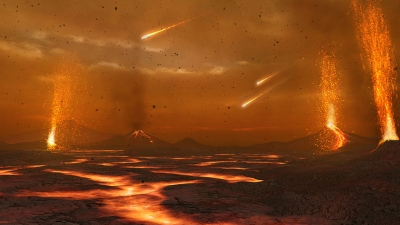
|
At the start, it was just a fiery ball of molten (liquid) rock. As it cooled, lumps formed on the surface of the molten rock. The surface gradually hardened into a crust. Volcanoes kept on pouring steam and gases onto the surface, which led to the atmosphere being formed. As Earth cooled further, clouds of steam became water, creating vast oceans. The crust eventually cooled to form the continents. |
Three recent studies improve our understanding of environmental conditions on early Earth—important not just for reconstructing the history of our own planet, but for assessing the habitability of planetary bodies in general.
The first of these studies was led by John Tarduno from the University of Rochester and reported in Proceedings of the National Academy of Sciences. The authors present evidence of a strong magnetic field around Earth, from about 4.1 billion to 4 billion years ago. Their conclusion is based on magnetite inclusions in certain minerals (zircons), and thus appears to be very reliable. A strong magnetic field would have been critical for life to originate on Earth, because it would have protected the surface from the solar wind. Stars like our Sun are known to expel large amounts of harmful radiation when they are still young, and without a magnetic field it is doubtful life on Earth’s surface would have been able to survive the barrage.
credit: smithsonianmag
Picture credit: Google



